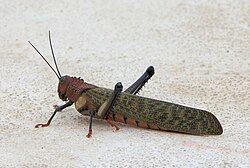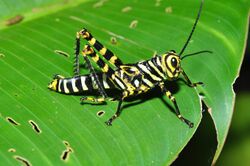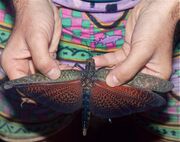Biology:Tropidacris cristata
| Tropidacris cristata | |
|---|---|

| |

| |
| Adult above, nymph below (both in Costa Rica) | |
| Scientific classification | |
| Domain: | Eukaryota |
| Kingdom: | Animalia |
| Phylum: | Arthropoda |
| Class: | Insecta |
| Order: | Orthoptera |
| Suborder: | Caelifera |
| Family: | Romaleidae |
| Subfamily: | Romaleinae |
| Tribe: | Tropidacrini |
| Genus: | Tropidacris |
| Species: | T. cristata
|
| Binomial name | |
| Tropidacris cristata (Linnaeus, 1758)
| |
| Synonyms | |
| |
Tropidacris cristata, the giant red-winged grasshopper, is a widespread species of lubber grasshopper in the family Romaleidae from tropical South and Central America, and Mexico.[1][2][3] It is among the largest grasshoppers in the world by length and wingspan, reaching up to 14.5 cm (5.7 in) and 24 cm (9.4 in) respectively.[4][5] More typical adult lengths are 5.5–7 cm (2.2–2.8 in), average 6.5 cm (2.6 in), in males and 7–12 cm (2.8–4.7 in), average 11 cm (4.3 in), in females.[6][7] As suggested by the common name, adult T. cristata have conspicuously red wings in flight, although the exact red hue varies.[6] The flightless and gregarious nymphs have aposematic dark-and-yellow stripes and are presumed to be toxic.[5][7]
T. cristata occurs in a wide range of habitats, both in lowlands and highlands.[3][8] In the southern part of its distribution, it is largely restricted to humid and semi-humid forested regions, avoiding places that are open and dry, but in the northern part it also occurs in somewhat drier habitats.[3][8] It is generally quite common, although the blue-winged T. collaris often is more common where their ranges overlap in South America (only T. cristata is found in some parts of northwestern South America and in Central America).[4][8]
T. cristata feeds on many types of plants and occasionally it is regarded as a pest.[6][7][8] The lifecycle is annual with overlapping generations,[9] but in some regions there is a level of seasonality in the occurrence of adults and nymphs.[7] The female lays an egg sac that contains up to 100 eggs in the soil.[9]
Subspecies
There are three subspecies of Tropidacris cristata:[3][8]
- Tropidacris cristata cristata (Linnaeus, 1758) – central and northern South America (west of the Andes south to Ecuador, east of the Andes south to the Cerrado region), southern Central America (Costa Rica and Panama), and Trinidad and Tobago
- Tropidacris cristata dux (Drury, 1770) – Mexico and Central America (south to Nicaragua)
- Tropidacris cristata grandis (Thunberg, 1824) – south-central South America (northernmost Argentina , Uruguay, easternmost Paraguay, and southern and southeastern Brazil ; a few records from the Amazon, which typically is inhabited by T. c. cristata)
References
- ↑ "Tropidacris cristata". https://www.gbif.org/species/1715295.
- ↑ Otte, Daniel; Cigliano, Maria Marta; Braun, Holger; Eades, David C. (2019). "species Tropidacris cristata (Linnaeus, 1758)". http://orthoptera.speciesfile.org/Common/basic/Taxa.aspx?TaxonNameID=1116272.
- ↑ 3.0 3.1 3.2 3.3 Carbonell, C.S. (1986). "Revision of the Neotropical Genus Tropidacris (Orthoptera, Acridoidea, Romaleidae, Romaleinae)". Proceedings of the Academy of Natural Sciences of Philadelphia 138 (2): 366–402.
- ↑ 4.0 4.1 Dinez-Filho, J.A.F. (2010). "Ensemble forecasting shifts in climatically suitable areas for Tropidacris cristata (Orthoptera: Acridoidea: Romaleidae)". Insect Conservation and Diversity 3 (3): 213–221. doi:10.1111/j.1752-4598.2010.00090.x.
- ↑ 5.0 5.1 Whitman, D.; Vincent, S. (2008). "Large size as an antipredator defense in an insect". Journal of Orthoptera Research 17 (2): 353–371. doi:10.1665/1082-6467-17.2.353.
- ↑ 6.0 6.1 6.2 Duranton, J.M.; Launois, M.; Launois-Luong, M.-H.; Lecoq, M. (1987). Guia prático de luta contra os gafanhotos devastadores no Brasil. Food and Agriculture Organization. p. 43. ISBN 2-87614-006-3.
- ↑ 7.0 7.1 7.2 7.3 Pech, M.A.P. (2021). "Ficha técnica: "Chapulín Gigante Tropidacris cristata dux" (Orthoptera: Romaleidae)". Organismo Internacional Regional de Sanidad Agropecuaria. http://apps.iica.int/gicsv/programas/SanidadVegetal/archivos/Langosta/Anexo%202.%20Ficha%20Tropidacris%20GICSV%20en%20Revisi%C3%B3n.pdf.
- ↑ 8.0 8.1 8.2 8.3 8.4 Paula Romão, E.d. (2017), Distribuição geográfica e potencial das espécies do gênero Tropidacris Scudder, 1869 (Orthoptera: Romaleidae), Pará State University
- ↑ 9.0 9.1 "Gigant grasshopper Tropidacris cristata – Lifecycle". National University of Colombia, Museum of Natural History. http://historianatural.unal.edu.co/expo1/saltamontes_eng.html.
External links
Wikidata ☰ Q10287970 entry
 |



